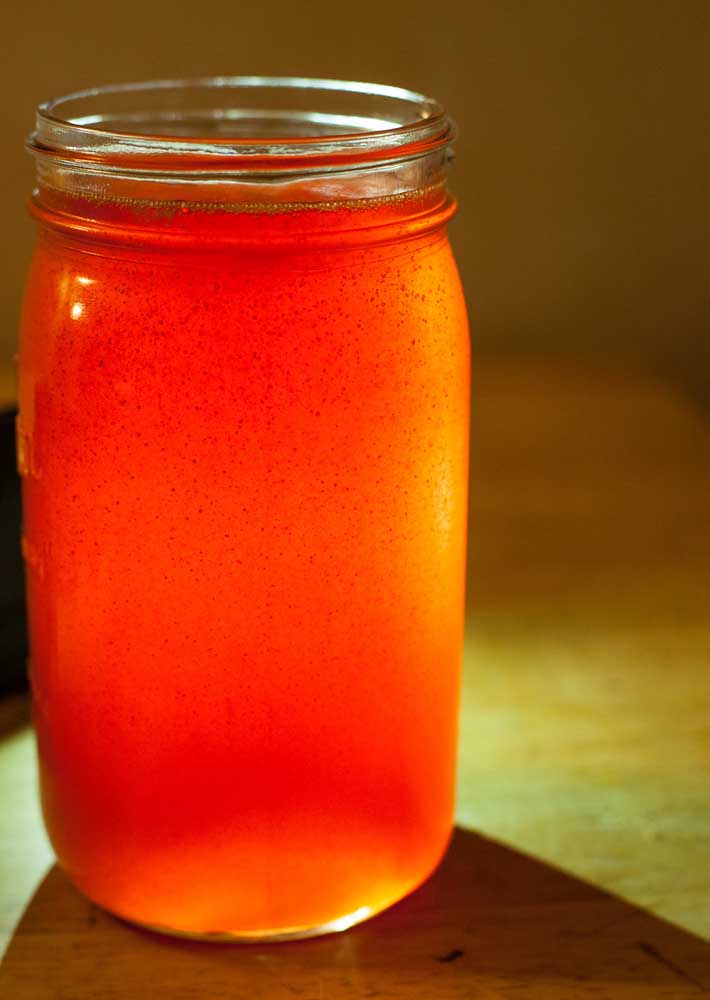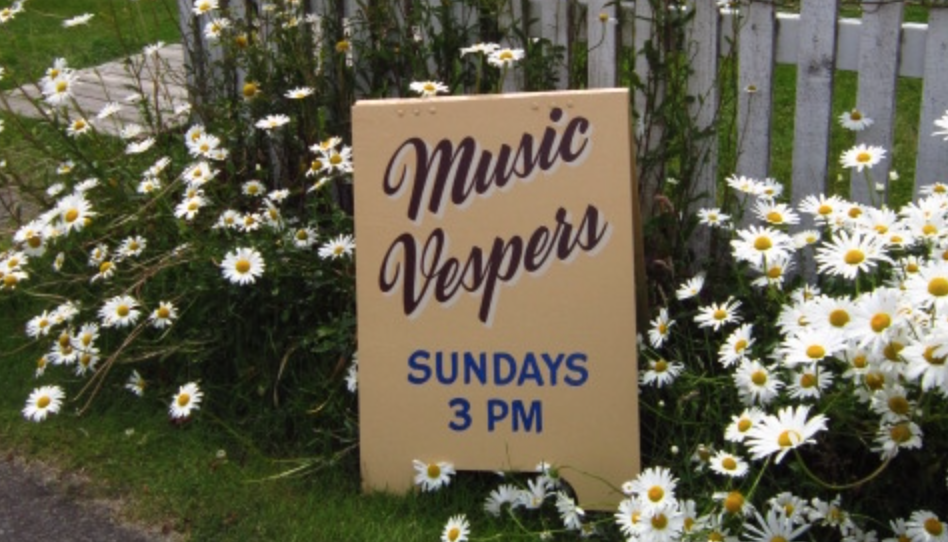Hearthfire & Brimstone: Rhubarb syrup: A sweet-tart way to celebrate summer
Published 11:36 am Tuesday, June 19, 2018

- Homemade rhubarb syrup is delicious, versatile and beautiful.
Last week in the fly-over states, people were complaining about the humidity. Kids in the South were wearing holes in their Slip-n-Slides. On the East Coast, the wealthier-than-thou were having their maids get their precious little Brocks and Francescas packed for another summer at Camp Wedidntwantcha. I knew summer was also in full-swing here, because my colleague quit wearing his down jacket indoors. And, our first farm box arrived, filled with rhubarb. Elsewhere in the world, these ruby-red stalks are a sign of spring, but here, they ripen right around the time the kids get out of school.
I like strawberry-rhubarb pie as much as the next person, but a gal can only eat so much pie. There are actually lots of other ways to eat this not-a-fruit. You can pickle it, poach it, roast it or turn it into jam, chutney or sauce, but I strongly recommend making syrup; a simple process that yields a delicious, versatile and beautiful product that keeps for ages.
As with nearly everything I write about, rhubarb has a surprisingly weird history. Much like the money and propaganda that got our president into office, it hails from Russia. The first mentions of the plant appeared about 2,700 years in ago, in “The Divine Farmers Herb-root Classic,” a sort of ancient Chinese Farmers Almanac. Silk Road merchants carried the increasingly-popular “Russian Rhubarb” from China to Western Asia and beyond. The Black Death and rhubarb both reached Europe in the 14th century.
The difficulty of transporting rhubarb across hundreds of miles by camel-train made it extremely expensive in medieval Europe. For a while, it was several times more valuable than other coveted eastern “spices,” including saffron and opium. That led Marco Polo to look for cheaper and faster ways to move the stuff west. Around 1403, a Spanish ambassador, Ruy Gonzalez de Clavijo, noted that “The best of all merchandise coming to Samarkand was from China: especially silks, satins, musk, rubies, diamonds, pearls, and rhubarb…”
Despite its popularity with rich people, rhubarb wasn’t — and still isn’t — universally-loved. When I asked my Facebook friends what they do with it, most shared happy memories of pie-making grandmas, but of couple of them had deep misgivings.
“How about a zucchini-rhubarb casserole, which you could then add to the compost pile?” my father wrote. “Remember, it would not be necessary to use up the rhubarb if you didn’t grow it in the first place!”
“I won’t eat rhubarb because I don’t like the looks of it and I don’t like the name,” my friend Amy said.
The plant probably does merit a bit of suspicion, as parts of it are poisonous, due to a high concentration of oxalic acid. In small doses, it gives the stalks their characteristic zip. Unless you’re susceptible to kidney stones or gout, they’re perfectly safe, even when raw. In some parts of the world, raw stalks eaten with salt and chile, and in Northern Europe, people dip them in sugar. However, the leaves have so much oxalic acid that they can cause severe kidney damage. Ostensibly in the name of “science,” some researcher figured out that rhubarb leaves, like cocaine, can be cooked down with baking soda to make a far more potent product. In this case, poison. No wonder the Russians liked it.
For a long time, rhubarb was mainly used for medicinal purposes. It has long been considered to be both a cathartic — something that makes you poop more — and a laxative — something that makes you poop more easily. In his scintillating 1911 classic, History of the Vegetable Drugs of the Pharmacopeia of the United States, pharmacist John Uri Lloyd provided numerous recipes for rhubarb-based “elixirs,” one of which he recommended for disguising the taste of castor oil.
It didn’t really catch on as a food until sugar became widely available and affordable to common people. When it finally caught on with the non-constipated in England, boy, did it ever catch on.
England’s “Rhubarb Triangle,” a nine-square-mile area in north-central England was once the forced-rhubarb-growing capital of the world. Has there ever been a more catchy tourism slogan than “Former forced-rhubarb-growing capital of the world”? The villages and towns there all have silly, fun-to-say names like “Kirkhamgate,” “Lofthouse” and “East Ardsley,” where, I imagine, a higher-than-average number of vicars are murdered in quaint settings. Or so BBC would have me believe.
Growers there really put the ‘cult’ in “cultivation” by using a highly ritualized growing method first developed in the early 1800s. In those heady early days of the “rhubarb industry,” the plants spent their first two years growing in fields, fertilized by a fragrant mix of horse manure, “night soil” (hint: it doesn’t have anything to do with soil) and waste from nearby woollen mills. The plants had little to do but suck up sun, grow strong on that delightful proprietary blend of fuzz and doo-doo, and store up energy in their roots. But in November of their second year, things inevitably got weird.
To this day, the mature plants are still moved to long, low-slung growing sheds after the first frost. They are kept in relative warmth and total darkness. Traditionally, they were harvested by candlelight, because stronger lights would stop the plants from cranking out more of the smooth, tender, sweet-tart red stalks that are so prized amongst forced rhubarb aficionados. Wikipedia didn’t say whether the workers wear hooded black cloaks or chant ominously while harvesting by candlelight, so we should just assume that they do.
For more than a century, the rhubarb industry was going so gangbusters that there was even a “Rhubarb Express” train that carried away as much as 200 tons of rhubarb annually. But all good things come to an end, and the rhubarb boom went bust at the beginning of World War Two. By the time the war ended, people had access to more exotic fruits, so rhubarb never made a full comeback. The triangle shrank to about a third of its former size. Today, far fewer young men have to explain to their dates that working in a so-called “forcing-shed” isn’t nearly as bad as it sounds.
That brings us up to the present. Oregon and Washington are unique in being among the very few places where there are two harvests of rhubarb: one in late spring, and one in mid-summer. When you’re faced with a fruit that’s available by the bushel, but only for three weeks at a time, syrups are the easiest way to keep it from going to waste. You can pour them over pancakes or ice cream, add them to fruit salads, pies or crisps, blend them into slushies or intensely-flavored milkshakes, add them to iced tea, lemonade, soda water or cocktails. Or you can make my hands-down favorite glaze for barbecued chicken or ribs, which blends rhubarb syrup with smoky chipotle chiles to give chicken a sweet-salty-hot-sticky lacquer that takes about a minute to make, and tastes like nothing else.
Making syrup is very easy. Wash however much rhubarb you want to use up, and cut off any ugly spots. Chop the rest into half-inch-thick pieces and put them in a pot. Add water almost to the top of the rhubarb, and throw in a pinch of salt. Put it on the stove over medium-high heat, and bring it to a gentle boil.
After a few minutes, your beautiful red rhubarb will disintegrate into wholly unappealing baby-poop yellow shreds. Keep it at a gentle boil, and cook until all of the stalks have broken down and turned the water a delicate pink. This should take about 20 minutes. You’ll see some foam form on top, but it really doesn’t matter.
Get out the finest strainer you have and place it over a large bowl or another pot. Pour the contents of the pan through the strainer. You’ll be tempted to mash that gunk to get out every last drop of juice. Don’t. If you get out all the solids, you’ll have a more clear syrup. If that’s your thing, you’ll need to strain it more than once, using something finer, like a flour-sack cloth or cheesecloth. I personally could care less if there are some solids in my jar of syrup, so I strain it just once or twice.
Clean your pan to remove any remaining rhubarb debris. Pour your juice into a measuring cup to see how much you have. Add it to the pan with an equal amount of sugar. You’ll likely feel a little dirty using four or five cups of sugar at once, but when you see how beautiful the syrup is, you’ll feel better.
Heat the mixture to a gentle boil, stirring occasionally. After a few minutes, solids in the syrup may coagulate and form a skin on top. Skim it off. How long you cook it down is mostly a matter of taste. If you prefer a light, thin syrup, cook it just until it coats the back of a spoon. If you like a thicker, punch-you-in-the-teeth-with-flavor syrup, keep on boiling it down until it concentrates to the consistency of pancake syrup and develops a deeper red color.
With a high sugar and acid content, the syrup will keep for quite some time in a closed jar in the fridge. If you want to be on the safe side though, you could always seal it in canning jars in a hot water bath.
The glaze is scarcely even a recipe. Buy a can of chipotle chiles en adobo. You can find these is the Mexican aisle of any decent grocery store. Measure out about 1 ½ cups of rhubarb syrup. Add one chile from the can, a splash of the adobo sauce that it was swimming around in, and a generous two-finger pinch of kosher salt. Blend it, ideally with an immersion blender, and give it a taste.
This is really just a framework for improvisation. Sometimes I grate in a clove of garlic or add a squeeze of citrus. Sometimes, I replace the salt with good soy sauce or fish sauce. If you love spicy foods, you can add more chiles and adobo. A small dash of cinnamon and some white pepper would add an element of intrigue and mystery.
I like to soak chicken thighs in a mild brine for a couple of hours before grilling. After the chicken has been sitting on the grill for a few minutes, we start lacquering this glaze on, layer after layer until the chicken is cooked through and the outside is sticky, deep red, and a bit charred. You’re going to need an extra napkin and a good, cold beer to wash it down.





